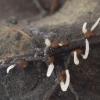
28-12-2025 12:08
Margot en Geert VullingsThis possible Karstenia was found on the bark of d

21-12-2025 21:32
Pol DebaenstHello, Garden, Burgweg 19, Veurne, BelgiumOn 10/1

26-12-2025 21:19
Arnold Bû¥schlenPithyella chalaudii Priou. Ist als Bryoparasit in

21-12-2025 09:32
Hello.A tiny ascomycete found embedded in wood in

18-12-2025 21:17
Pol DebaenstThe identification took me to Byssonectria deformi

24-12-2025 17:08
Hulda Caroline HolteHello, I have found this propoloid ascomycete on
 Hi all!
Hi all!It's the first time I have spoken in the forum, and here I bring these specimens asking for your help.
Specimens found in leaves of Castanea sativa.
A greeting and thank you very much!
Domingo ChûÀvez
Pero como bien sabes este hongo es un basidiomycete y en este foro tratamos sû°lo de ascomycetes.
Saludos
Before leaving this site with your "Non asco".ô Although Domingo is right in that you need microscopic detail to take it further as your Typhula has a visible sclerota it is not setipes but I think it might be T sclerotioides.
Mal

Un saludo a los dos!
Sorry for the error, and thank you very much for all the information and I will not forget some other time of the micro.
Thank you very much!
Domingo ChûÀvez
Typhula setipes is a typical folicolousô species of Typhula that grows on a sclerotium (one basidioma for eachô sclerotium). Typhula sclerotiorum grows on a sclerotium too but it prefers herbaceous stems.
I'm sorry but I think this fungus could be Typhula setipesô
Enrique
I think you're right. T. sclerotioides, mostly found on Petasites, is never folicolous and has a longer stipe. This could be T. setipes which sometimes can be found with a sclerotium, too. But the vermiform carpophores with those very short stipes look much more like T. corallina, a very polymorphous Typhula. But without knowing anything about the microscopical details ...
Kind regards,
Klaus
Malcolm
T. setipes grows on sclerotium, too to my experience. It is not rare even up here north on for instance Betula leaves.
With club fungi I often use also this key available in the internet: http://www.svims.ca/council/Clubs.htm?
Marja
nice key, but (of course) with some only from the American continent known species and containing a lot of gaps. What about such species as T. micans, T. anceps, T. (sub)hyalina, T. piceicola, T. quisquiliaris, T. corallina, T. culmigena, T. uncialis, T. lutescens, T. fruticum, T. euphorbiae, T. pachypus, T. todei (= T. athyrii), T. trifolii, T. variabilis, T. subvariabilis, T. spathulata, T. olivascens, T. graminum. T. caricina, T. capitata ?
So I think it's better to prefer Berthier's keys in his monograph or that one in Jû¥lich (1984).
Klaus
sometimes it is good to get a second description of a species and anything that can be taken seriously may help.
I sometimes wonder how the views to the same species vary from one source to another and that is true especially with ascomycetes. Even the colours of the fresh fungus on your hand and the description of dried material in the source can be very different not to mention microscophy.
I'm just an amateur with very limited collections of books and scientific studies. So I look desperately on internet to find keys and descriptions of species. I even lack the NM3. Maybe I'll loan it and scan to my computer.
Anyway you may be right. It may be better if I don't try to help folks here by offering links to keys I have found because I can't know weather they are proper.
Marja
I will try and get a copy of Berthier's keys? but thanks Marja for your link, even though it has species missing ;)
Mal

I am trying to send you a private mail, but it retun me an error.
Best regards.
with much interest I read your comment. I struggle with the same problem asô Domingo. Ik have a couple of Typhula's too on leaves and stems of leaves, also with a sclerotium. Ik read the key Marja has linked to. But I undertstand that you have another Key of the Typhula? I wonder if you can send me the link to the site orô belongs this in you own material. I is hard to find a good key of this sort.
Hannie
I have found some descriptions from internet.
For istance this contains some:
http://projet.aulnaies.free.fr/Florules/HYMENOMYCETES.pdf
Should study more this interesting language ;)
Marja
Hannie
